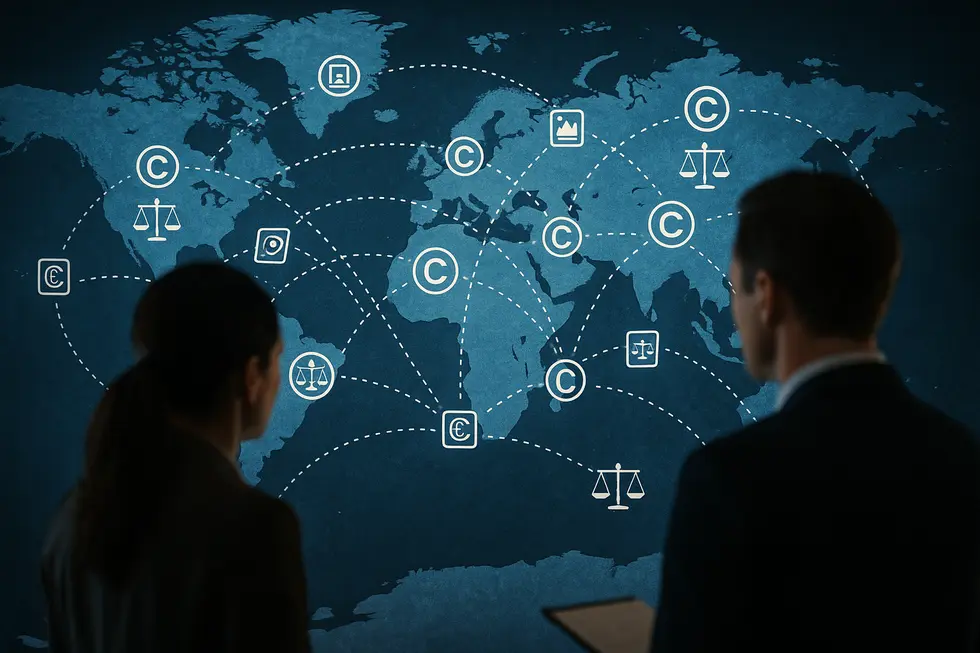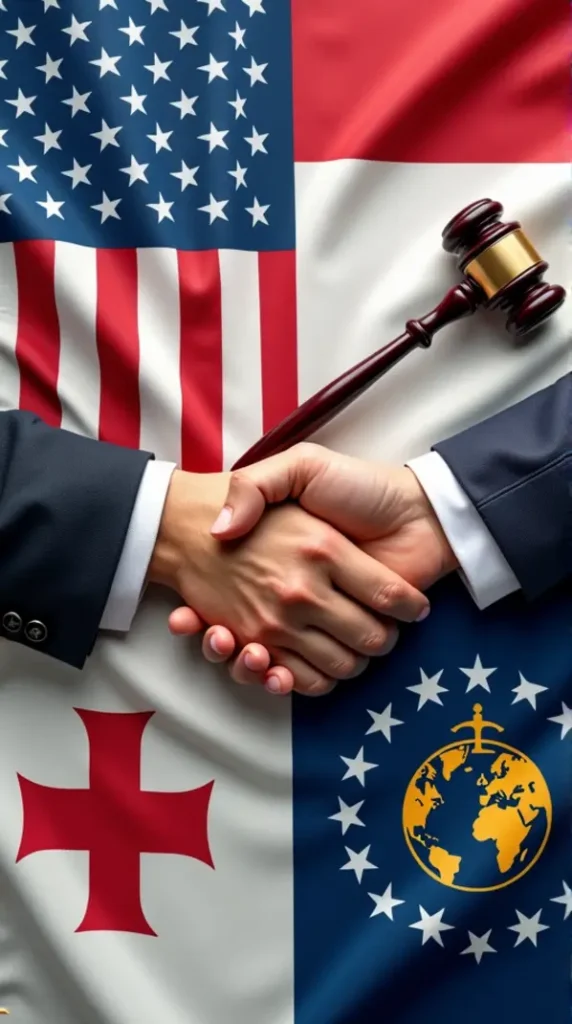Introduction
Copyright forms the foundation of intellectual property strategies in every modern business. Owners of original works are endowed with six exclusive rights, empowering them to control reproduction, adaptation, distribution, public performance, display, and—in the case of sound recordings—digital transmission of their creations. These rights not only protect creative investments, but also fuel competitive advantages, market expansion, and the smooth exchange of innovation. By delving into the legal foundations, exploring technological and economic impacts, and examining international operations, business owners can harness copyright’s full potential and stay ahead of risks and opportunities.
Tables of Contents
Chapter 1: Legal Framework and Definitions of the 6 Exclusive Rights of Copyright
- AI, Digital Technologies, and the Evolving Landscape of Copyright’s Exclusive Rights
- Monetizing Creativity: Economic Engines Within the Six Exclusive Copyright Rights
- Balancing Creativity, Global Cooperation, and Social Progress: Societal and Geopolitical Implications of Exclusive Copyright Rights
Chapter 2: Technological, Economic, and Societal Impacts of the 6 Exclusive Rights of Copyright
- Digital Frontiers: How the Six Exclusive Rights Shape Innovation, AI Creativity, and Online Distribution
- Copyright as Economic Engine: Monetization, Licensing Models, and Shaping Creative Market Forces
- Balancing Access, Creative Incentives, and Cultural Growth: The Societal Impact of Copyright’s Six Exclusive Rights
Chapter 3: Geopolitical and International Dimensions of the 6 Exclusive Rights of Copyright
- Navigating Borders and Bytes: The Influence of Technology and Global Politics on Exclusive Copyright Rights
- Global Trade, Creative Economies, and the Power of Exclusive Copyright Rights
- Cultural Sovereignty as a Battleground in Global Copyright Rights Negotiations
Chapter 1: Legal Framework and Definitions of the 6 Exclusive Rights of Copyright

1. AI, Digital Technologies, and the Evolving Landscape of Copyright’s Exclusive Rights
Technology has radically redefined the reach and nuance of the 6 exclusive rights of copyright, from reproduction to digital transmission. The legal framework, originally crafted around static works in physical media, now faces challenges from generative AI and digital ecosystems. Generative AI can automatically reproduce and adapt vast amounts of copyrighted work, often in ways that were not anticipated by traditional copyright law. For instance, when AI is trained on copyrighted materials scraped from the web, it may unwittingly create works that closely mimic original sources, raising issues about unauthorized reproduction or unlicensed derivative works.
This tension is especially acute with the derivative right, as output generated by AI may be based on or substantially similar to protected content. Legal disputes have highlighted these vulnerabilities, sparking debate over fair use, market harm, and the scope of what constitutes infringement. In parallel, the marketplace is shifting: rights holders and technology developers now negotiate copyright licensing for AI training, aiming to balance innovation with respect for creative ownership. Policymakers and courts are responding, with ongoing efforts to clarify—or perhaps rethink—how exclusive rights operate in the digital era. For further reading, the USF guide on Copyright and Generative AI offers an in-depth exploration.
2. Monetizing Creativity: Economic Engines Within the Six Exclusive Copyright Rights
The legal construct of the six exclusive copyright rights is foundational to the modern creative economy. Granting creators and copyright holders control over reproduction, adaptation, distribution, public display, performance, and digital transmission enables both artistic freedom and financial return. By law, these exclusive powers can be licensed—individually or collectively—turning creative works into vibrant economic assets. Rights holders exploit these mechanisms to recover the costs of creation and reap profits, an incentive described by both utilitarian and property-based legal theories.
Core copyright industries, bolstered by robust legal rights, contributed over $2 trillion to the U.S. GDP in 2023. This influence expands globally, as licensing and royalties cultivate local and international markets for literature, art, music, film, and software. The framework’s adaptability remains evident as technology advances; the recent surge in AI demands clear copyright licensing to support innovation and protect against infringement disputes. Creative industries thrive where the market for exclusive rights operates smoothly, connecting creators with consumers while sustaining cultural and economic growth. For a deeper look at AI, licensing, and market dynamics, see this copyright alliance article.
3. Balancing Creativity, Global Cooperation, and Social Progress: Societal and Geopolitical Implications of Exclusive Copyright Rights
The legal definition of the six exclusive rights of copyright is not only a technical matter—it serves as a crucial pivot between creators’ control and society’s flourishing. Copyright frameworks are shaped by an ongoing struggle to balance the incentives provided to original authors with the freedom of cultural adaptation, critique, and follow-up creation. By framing copyright as a right of artistic expression, courts often prioritize creators, yet this can suppress the voices of derivative creators and limit innovation.
At the geopolitical level, copyright is enmeshed in complex international treaties and territorial disputes. Differences in national protection and global enforcement lead to challenges in regulating digital distribution, fostering cultural exchange, and protecting economic interests for creators worldwide. These complications echo broader legal debates, such as those around territorial rights and national sovereignty—where definitions have far-reaching impacts on diplomacy, technology, and trade.
Ultimately, every adjustment to the scope or enforcement of these exclusive rights reverberates across borders and generations, shaping how societies access information and contribute to collective innovation. If you want to dive deeper into key facts and nuances of copyright, consider this comprehensive resource on copyright law. For scholarly analysis on copyright as a freedom of artistic expression, refer to this human rights overview.
Chapter 2: Technological, Economic, and Societal Impacts of the 6 Exclusive Rights of Copyright

1. Digital Frontiers: How the Six Exclusive Rights Shape Innovation, AI Creativity, and Online Distribution
The six exclusive rights of copyright exert profound influence over the constantly evolving landscape of digital creation and dissemination. As original works move fluidly between print, screen, and the cloud, these rights remain pivotal in defining the boundaries of ownership and use. The surge of artificial intelligence and algorithmic tools has generated novel works at an unprecedented scale, yet traditional copyright frameworks generally protect only human-authored content. This gap fosters uncertainty for those seeking to commercialize or license AI-generated materials, forcing developers and creators alike to negotiate complex legal ground and establish transparent licensing models.
Digital reproduction and distribution—whether music streaming, e-book sharing, or online exhibitions—are tightly regulated under exclusive rights, making robust copyright protections essential for creators to retain control and monetize new forms of expression. Enforcement tools have grown more sophisticated, allowing for rapid detection and response to infringement. Additionally, a thriving licensing market for AI training data and creative technologies reflects a necessary balance: protecting original creators while empowering innovation through fair, consent-based collaboration. These developments are driven and shaped by the technology-agnostic nature of copyright law, which remains vital for digital content protection and innovation. Read more on copyright and AI-generated works.
2. Copyright as Economic Engine: Monetization, Licensing Models, and Shaping Creative Market Forces
The six exclusive rights conferred by copyright law form the economic backbone of creative industries, transforming ideas into revenue and shaping entire markets. Regulation of reproduction, adaptation, distribution, public performance, display, and digital transmission empowers creators to not only safeguard—but capitalize on—their works. Monetization occurs through direct sales, royalties, and, crucially, through licensing. Granting licenses, whether exclusive to a single partner or non-exclusive to many, enables copyright holders to reach broader audiences and diversify income while retaining fundamental control. This system fuels significant economic value; the U.S. copyright sector alone contributes trillions to GDP and underpins millions of jobs, bolstering both cultural output and employment.
Market dynamics are also molded by copyright’s framework. The ability to control use helps drive competition, foster innovation, and maintain creative diversity. However, complex licensing, rising enforcement costs, or narrow rights management—especially for disruptive fields like AI—may present challenges for smaller firms and shape industry consolidation. Balancing protection with fair access is essential to sustaining both innovation and creator incentives. For more on licensing’s evolving impact, see the Copyright Alliance’s discussion of AI copyright licensing.
3. Balancing Access, Creative Incentives, and Cultural Growth: The Societal Impact of Copyright’s Six Exclusive Rights
The six exclusive rights at the heart of copyright protection shape cultural life in complex, often subtle ways. By granting creators control over duplication, adaptation, distribution, public performance, display, and digital transmission, copyright law provides a crucial incentive for artistic and intellectual innovation. Creators are rewarded with the ability to license or profit from their original expressions, fostering new works and a continually evolving cultural landscape.
Yet, these same exclusive rights naturally generate boundaries around cultural access. While they secure economic rewards for authors, performers, and innovators, they can sometimes restrict the public’s ability to use, learn from, or creatively build upon prior works. This tension is mediated through carefully designed exceptions—like fair use—which enable education, research, and critique, ensuring society at large can benefit from and participate in cultural production. As a result, copyright law underpins both vibrant creative markets and the free exchange of knowledge essential to democratic discourse. The perpetual challenge remains striking a balance: encouraging creation without stifling future expression or limiting access to culture. For further reading on this interplay, see Introduction to Copyright Law.
Chapter 3: Geopolitical and International Dimensions of the 6 Exclusive Rights of Copyright

1. Navigating Borders and Bytes: The Influence of Technology and Global Politics on Exclusive Copyright Rights
The terrain of copyright has been radically reshaped by the intersection of rapid technological progress and evolving geopolitical postures. The six exclusive rights, once rooted in material forms, now operate in a world where digital media ignore physical borders. Digital reproduction and instant distribution have made enforcement of copyright law across multiple jurisdictions far more complex. Licensing agreements, historically tied to regional restrictions, now contend with ubiquitous online platforms and the possibility of global access with a single click.
Meanwhile, geopolitics colors the application and negotiation of copyright rules on the international stage. States may use copyright policies as instruments of cultural sovereignty or economic leverage, with international agreements like the Berne Convention seeking harmonization but encountering resistance due to divergent national interests. Space exploration introduces new frontiers, provoking debate about ownership and control of creative works beyond Earth’s established legal frameworks. These pressures require ongoing adaptation, with nations updating laws to safeguard rights or assert sovereignty over content.
To better understand the interplay of technology, sovereignty, and copyright, readers can consult the US Naval War College Guide on Copyright.
2. Global Trade, Creative Economies, and the Power of Exclusive Copyright Rights
The six exclusive rights of copyright are much more than legal privileges—they are engines driving creative economies worldwide. By enabling creators to control reproduction, distribution, performance, display, adaptation, and digital transmissions, these rights fuel the global trade of creative works. Copyright holders monetize their assets by licensing works internationally, directly impacting economic growth and innovation. For example, in the United States, copyright-intensive industries generated $2 trillion for the GDP in 2023, a testament to the transformative power of these exclusive rights.
Internationally, copyright provisions are now ingrained in major trade agreements, influencing market access and harmonizing regulatory frameworks. The EU-Mercosur Partnership illustrates how intellectual property protections help safeguard the economic sustainability of creative sectors in the face of shifting global powers. Strategic enforcement and deeply rooted legal regimes help mitigate losses from infringement, supporting both individual creators and entire industries. For those considering the cost of expert guidance in protecting these assets globally, see this concise copyright lawyers cost guide. Further reading on international legal frameworks and economic impacts is available in the EU-Mercosur Partnership Agreement.
3. Cultural Sovereignty as a Battleground in Global Copyright Rights Negotiations
At the intersection of international copyright law and statecraft lies the complex contest for cultural sovereignty. As the six exclusive rights of copyright—covering reproduction, distribution, performance, display, derivative works, and digital transmission—set global frameworks for creative control, nations increasingly leverage these legal tools to safeguard their unique cultural identities. This struggle is particularly evident where states perceive international copyright norms as vehicles for cultural homogenization or economic dependency. Countries like China and Russia have established robust policies prioritizing domestic cultural content and resisting what they view as Western-centered intellectual property agendas. In contrast, transnational bodies often advocate for standardization, encountering resistance from countries in the Global South that seek to protect indigenous heritage and local expression within copyright structures. These divergent approaches also influence debates on emerging technologies such as AI, where the framing of cultural content under copyright differs sharply based on political context. Thus, copyright’s exclusive rights become not just instruments of private gain, but active arenas for asserting or defending cultural sovereignty. For a deeper dive into the geopolitical and cultural dimensions shaping copyright battles, see this overview of copyright as cultural sovereignty and investment risk.
Final thoughts
The six exclusive rights of copyright form an essential pillar in every business owner’s toolkit, encompassing legal protection, commercial opportunity, and strategic adaptability in a globalized market. By understanding these rights, their technological implications, economic value, and international nuances, business leaders can unlock potent benefits—safeguarding assets, licensing creativity, and ensuring compliance while fueling growth. Knowledge and proactive management are key to thriving in an environment shaped by rapid change and innovation.
Get your trademark today! Thousands have protected their brand by filing a trademark. What are you waiting for? Start your trademark application!
About us
The globe’s top website for registering trademarks and safeguarding your brand, name, logo, or slogan. We deliver seamless registration, strategic guidance, and robust protection to ensure your identity and intellectual property remain secure in every market, empowering creators and business owners worldwide.





